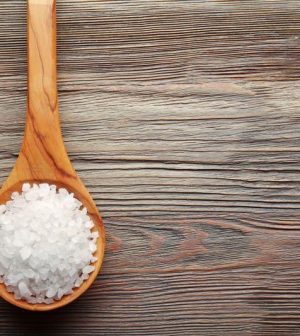- Skip Storing This Everyday Product in the Fridge Door
- Green Tea + B3 Pairing May Boost Brain Health
- Navigating Your Midlife Crisis: Embracing New Possibilities
- City Raccoons Showing Signs of Domestication
- Mapping the Exposome: Science Broadens Focus to Environmental Disease Triggers
- One Week Less on Social Media Linked to Better Mental Health
- Your Brain Changes in Stages as You Age, Study Finds
- Some Suicide Victims Show No Typical Warning Signs, Study Finds
- ByHeart Formula Faces Lawsuits After Babies Sickened With Botulism
- Switch to Vegan Diet Could Cut Your Greenhouse Gas Emissions in Half
Avoid These 15 Foods to Lower Your Salt Intake

Americans eat too much salt and more than a dozen favorite and convenience foods are largely to blame.
Nearly 90% of Americans exceed dietary guidelines for sodium intake, a risk factor for high blood pressure and heart disease.
New research out of Canada put some familiar favorites at the top of the list.
“The top 15 food category contributors to dietary sodium represent just over 50% of total dietary sodium intake for American adults, with pizza, breads, cold cuts, soups and burritos being the top five contributors,” the study authors said in a news release from the Institute for the Advancement of Food and Nutrition Sciences.
At the top of the list is pizza with 5.3% of total dietary sodium intake, followed by breads, rolls and buns at 4.7%.
After that is cold cuts and cured meats at 4.6%; soups at 4.4%; burritos and tacos with 4.3%; savory snacks at 4.1%; and poultry at 4%.
Rounding out the bottom half of the list and comprising between 1.5% and 3.1% of sodium intake are cheese; pasta mixed dishes; burgers; meat mixed dishes; cookies, brownies and cakes; bacon, frankfurters and sausages; vegetables; and chicken nuggets.
For the study, University of Toronto researchers used U.S. health survey data for 2017 to 2018. The survey asked respondents to recall what they ate.
Education and food-labeling campaigns to get people to cut back on salt had little impact, according to the study authors.
Identifying these top salt sources may help inform future policies and programs designed to reduce sodium intake, the researchers suggested.
“This data is important in light of the FDA Voluntary Sodium Reduction Goals, which bring renewed focus on the importance of limiting sodium in the food supply and can help focus future efforts,” said lead study author Mavra Ahmed, a post-doctoral fellow at the University of Toronto.
The World Health Organization and U.S. Centers for Disease Control and Prevention recommend limiting sodium intake in order to lower the risk of heart disease — a leading cause of death in North America.
“The present research contributes important information pertaining to the food categories that would be amenable to reformulation and have significant impact on Americans’ diets,” the study authors concluded.
The findings were recently published in the journal Nutrients.
More information
The U.S. Centers for Disease Control and Prevention has more on sodium.
SOURCE: Institute for the Advancement of Food and Nutrition Sciences, news release, Feb. 13, 2023
Source: HealthDay
Copyright © 2025 HealthDay. All rights reserved.










